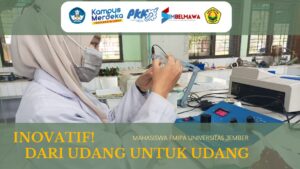 The PKM-Riset Eksakta Team, Faculty of Mathematics and Natural Sciences, University of Jember, headed by Rikma Dwi Mukharomah from the Chemistry Department, converted shrimp shells into chitosan, which was applied as a bioflocculant for treating waste water in shrimp ponds. This research team consists of Masrurotul Alfiah, Imelda Dwi Puspita, and Ka’aziyah Aulia Nada from the Chemistry Department and Indah Febrian from the Biology Department. Dr. Bambang Piluharto, S.Si., M.Si., from Department of Chemistry, FMIPA, was appointed as supervisor of the PKM-Exact Research Team, which won funding for the 8 Bidang Program Kreativitas Mahasiswa (PKM) in 2023.
The PKM-Riset Eksakta Team, Faculty of Mathematics and Natural Sciences, University of Jember, headed by Rikma Dwi Mukharomah from the Chemistry Department, converted shrimp shells into chitosan, which was applied as a bioflocculant for treating waste water in shrimp ponds. This research team consists of Masrurotul Alfiah, Imelda Dwi Puspita, and Ka’aziyah Aulia Nada from the Chemistry Department and Indah Febrian from the Biology Department. Dr. Bambang Piluharto, S.Si., M.Si., from Department of Chemistry, FMIPA, was appointed as supervisor of the PKM-Exact Research Team, which won funding for the 8 Bidang Program Kreativitas Mahasiswa (PKM) in 2023.
“This research is expected to be an alternative to processing waste water from shrimp ponds,” said Rikma Dwi Mukharomah. The research was carried out for 4 months, starting June 16, 2023, at the Physical Chemistry and Organic Chemistry Laboratory, Department of Chemistry, FMIPA, University of Jember. Furthermore, Rikma explained that chitosan-based bioflocculant is synthesized from shrimp shells through several stages, including deproteination, demineralization, and deacetylation. “The result obtained after the deproteination and demineralization processes is chitin, while from the chitin deacetylation process, chitosan is obtained,” she explained.
The bioflocculant in this research was synthesized in the form of beads, which have the advantages of being easily separated and having a porous surface. “The synthesized chitosan beads were then tested for their performance as a bioflocculant in treating shrimp pond wastewater,” said Rikma. And the parameters observed in the PKM-Exact Research team’s research were turbidity, pH, COD, and TSS.
Based on the research results, it can be concluded that the chitosan-based bioflocculant from shrimp shells is effective at a dose of 9 g/L with turbidity results of 1.5% and a COD of 1684 ppm. “The PKM-Exact Research Team will also produce progress reports, final reports, scientific articles, and social media publications as research outputs,” she concluded.
